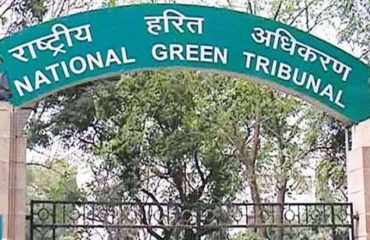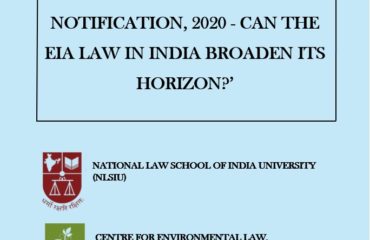Introduction
Sustainable development is a concept which aims to ensure the sustainable use of resources to satisfy the necessities of the current generation without jeopardizing the capability of the future generations to address their needs. To attain a sustainable future, a set of 17 goals named as Sustainable Development Goals (SDG) were identified in 2015 to be achieved by 2030 by all the 193 Member States of the UN. With the principle of “Leave No One Behind”, the SDGs aimed at sustainable social, economic and environmental development. This blog would examine the environment-oriented SDGs and India’s progress to achieve those goals. Those goals ensure clean water, sanitation and affordable, clean energy ( SDG 6 and 7 respectively), sustainable communities and cities (SDG 11), responsibility in consumption and production (SDG 12),conserving life on land and below water(SDG 15 and 14 respectively) and climate action (SDG 13).[1]
Global Performance On Sdg Index, 2020
The Sustainable Development Report 2020 traces the performance of the 193 states (though 166 are ranked in SDG index) towards achieving the 17 SDGs. Sweden topped the list of SDG 2020 index with a score of 84.7 out of 100, which was followed by Denmark and Finland with a score of 84.6 and 83.8 respectively. With a score of 61.92, India has been ranked 117 in the SDG Index 2020. By this India has slipped two ranks below its rank in 2019 i.e. 115(out of 162 countries) with a score of 61.1. [2] The Report shows that in most of the countries challenges are faced in achieving the environmental oriented SDGs. Even in the OECD countries, which have fared well in comparison to other countries in progressing towards achieving other SDGs, yet they show a major setback in attaining these environmental oriented SDGs mainly due to negative international spillovers. According to the Report, overall, the East and South Asian countries have fared the best in clean and affordable energy but these countries show a negative trend in conserving life on the land and taking climate action Overall performance of the countries in the regions of Eastern Europe and Central Asia, Latin America and the Caribbean fared the best in ensuring affordable and clean energy. However, they face challenges conserving life on the land. The countries in the Middle East and North African regions face major challenges in achieving almost all the SDGs. Similar situation exists in the Sub-Saharan African region, but their overall performance has enhanced considerably since 2015. Though the Report claimed unavailability of data to comment upon the overall performance of the countries in the Oceania region, the region fared best in progressing towards SDG 12. [3]
Understanding India’s Trend On Achieving Environmental Oriented Sdgs
Neither much concern nor progress was shown in the first two years after the SDGs came into picture in 2015 towards achieving these environmental SDGs. The Voluntary National report on the Implementation of the SDGs 2017(hereinafter referred to as VNR) of India did not even report on the progress made towards any of these environmental SDGs except SDG 14.[4] However, in contrast to that the VNR, 2020 covers the progress of the nation towards all the SDGs in detail.[5] This shows the increased concern towards achievement of these SDGs. To understand the concerns regarding the achievement of the environmental SDGs, it is important to examine the SDG rating and SDG trend for the past years. Table 1 shows the SDG rating and SDG trend since 2017.
Table 1: Table showing the nature of challenges and the trend in achieving SDGs since 2017 [6]
| Year | Nature of challenge that remain | SDG
achieved |
SDG Trend | |||||
| major | significant | challenge remain | increasing | moderately increasing | decreasing | stagnating | ||
| 2017 | SDG 7, 11,14 | SDG 6,12,13, 15 | – | Not available | ||||
| 2018 | SDG 7, 11,14 | SDG 6,12,13, 15 | – | – | – | SDG 6, 14 | – | SDG 7,11,15,13 |
| 2019 | SDG 7, 11,6 | SDG 14,15 | SDG 12,13 | – | SDG 13 | SDG 6,7 | SDG 15 | SDG 14,11 |
| 2020 | SDG 7, 11,6 | SDG 14,15 | SDG 12 | SDG 13 | SDG 6,13 | SDG 7 | SDG 15 | SDG 14,11 |
Constantly for past three years (2017-2020) according to the SDG Index, there is not much progress towards achieving two SDGs and major challenges remain in achieving the same – SDG 7 (clean and affordable energy) and 11 (sustainable cities and communities). Similarly since 2017, constantly significant challenges remain in conserving life on land (SDG 15) according to the SDG Index from 2017-2020. While significant challenges remained both in 2017 and 2018 in achieving SDGs 6, 12 and 13, major challenges remained in 2019 and 2020 in achieving SDG 6 and challenges remain in achieving SDG 12.[7]
One commendable improvement is the achievement of SDG 13(climate action) in 2020. Another improvement is that though there are major challenges to achieve SDG 6 (clean water and sanitation), still in 2020 it shows a positive increasing trend unlike in 2019 when it showed a moderately increasing trend. The main reason for concern is SDG 15 which faces significant challenges to be achieved but shows a negative trend in 2019 and 2020. Another cause of concern is the stagnating trend of SDG 14 and 11 which faces significant and major challenges respectively in both 2019 and 2020.
Identifying The Gaps
Non-Availability of data to measure the indicators
There are different indicators for different SDGs which are used to estimate the progress achieved with regard to that SDG. However, data is unavailable for most of the environmental SDGs. Table 2 compiles the statistics showing the number of indicators to be measured and the number of indicators for which data is unavailable. Clearly, from Table 2 it is understood that except for SDG 7, there is a lack of data to measure the indicators for all the other environmental SDGs. The worst is SDG 12 for which data is not available for any of the indicators for SDG Index 2020 and only 3 indicators out of 14 indicators are available in the National Indicator Framework Progress Index 2020.[8] In absence of such data, it is difficult to estimate the progress in achieving that particular SDG.
Lack of certain indicators in the SDG Index
Other than the government implementing the schemes, affirmative public cooperation plays an important part in ensuring achievement of the sustainable development goals. However, this is not considered as an indicator in the SDG index. Similarly, even though there is SDG 16 aiming towards building strong justice system, it takes into account indicators like no. of under un-sentenced prisoners, homicides, women safety, corruption and property rights etc. However, cruelty to animals is not measured in any of the indicators- neither in SDG 14, 15 nor 16.
Table 2: Table showing unavailability of Indicators used to estimate progress towards SDGs [9]
| SDG Goal No. | SDG | SDG INDEX 2020 | SDGs National Indicator Framework Progress Report 2020 | ||
| No. of indicators
Measured |
No data available for no. of indicators (To analyse SDG trend) | No. of indicators
Measured |
No Data available for no. of indicators | ||
| 6 | Clean water & sanitation | 5 | 2 | 17 | 7 |
| 7 | Clean & affordable energy | 3 | – | 4 | – |
| 11 | Sustainable Cities & Communities | 3 | – | 15 | 7 |
| 12 | Responsible Consumption & Production | 6 | 6 | 14 | 11 |
| 13 | Climate Action | 3 | 1 | 5 | 2 |
| 14 | Underwater life | 5 | 1 | 11 | 4 |
| 15 | Life on Land | 5 | 2 | 15 | 3 |
Accounting For The Probable Reasons For Challenges To Achieve
Sdgs And Sdg Trend
SDG 6
Probable Reason for increasing trend may include-
- Establishment of Ministry of Jal Shakti in May 2019 to look into the challenges associated with management of water by integrating Ministry of Water Resources and Drinking Water and Sanitation and River Development and Ganga Rejuvenation.[10]
- Increase in accessibility of clean and adequate drinking water through pipe water system in the rural India from 36.52% in 2017 to 40.5 % in 2019.[11]
- A whooping increase to 88.13 % of the districts in India being open defecation free in 2019 from only 18.45 % in 2017 under the Swacch Bharat Abhiyan. [12]
- Taking measures for conserving water through rainwater harvesting, other traditional methods, recharging and reusing water and watershed management through Jal Shakti Abhiyan in 2019. [13]
Probable reasons for remaining major challenges may include-
- Lack of availability of freshwater resources due to groundwater contamination caused by point (e.g. by industries) or non-point source of pollution (e.g. by agriculture). [14]
- Lack of database at local level to monitor issues related to water
- Different water laws across the country in different states leading to different rates of implementation of water laws and conservation strategies of water in the states.
- Though apparently, it may look that the sanitation facilities have improved after the increase in open defecation free districts, however, problems may persist as the nation still lacks separate toilet facilities that are needed for men and women.[15]
SDG 7
Probable Reason for moderately increasing trend
- Almost all villages in India are electrified under the Pradhan Mantri Sahaj Bijli Ghar Yojna. [16]
- Dependency on clean fuel has increased to 96.22 % in 2019 from only 63.11 % in 2015-16.
- UJALA scheme led to the reduction in carbon dioxide and conservation of energy upto 47kWh by distributing three hundred and sixty two million LED appliances in households under UJALA scheme. [17]
Probable reasons for remaining major challenges may include-
- Lack of technology, adequate manpower and money to support renewable energy at domestic level and
- Increasing demand for energy with simultaneous increased dependency on imports for appliances like solar panels etc. [18]
SDG 11
Probable reason for stagnating trend and remaining major challenges may include-
- There is no new schemes/mission that is launched in 2019 to work towards making the cities and the communities sustainable. The working of the existing schemes/missions is not satisfactory. For instance, there is Housing for All Scheme which aims to build affordable housing and redevelop sums for the slum dwellers by 2022. [19]However, the Scheme has been criticised for not being able to fulfil its targets.[20] Same is the case with the Smart City Mission.[21]
- Increasing air pollution in India calculated on the basis of annual concentration of particulate matter without any effective solution. India has one of the highest air pollution levels in the world.[22]
- Lack of funds for the existing schemes/missions to work properly due to inadequate financial autonomy to the Urban Local Bodies. [23]
SDG 12
Probable reasons for remaining challenges may include-
- India ranks second with respect to consuming materials in the world. However there is no policy/guideline/law to ensure the efficiency of resources and use of the secondary raw materials. [24]
- India generates about one lakh fifty thousand tonnes of municipal solid waste per day and Mumbai is the fifth most wasteful city in the world. Out of the waste generated only 83% of the waste India is collected and in that only 30 % is treated.[25]
- As indicated above, there is inadequate data to account for trend of this SDG.
SDG 13
Achievement of SDG may be attributed to the following-
- India ranked ninth out of sixty one countries in the world on the Climate Change Performance Index 2020 for emitting comparatively low level of per capita emissions and usage of energy. [26]
- Achievement of India’s voluntary commitment to reduce emissions intensity of GDP by 20-25% by 2020 taking 2005 as the base year under the UNFCC by reducing it to 21 % by 2020 [27]
SDG 14
Probable reasons for remaining significant challenges and stagnating trend may include-
- No policy to look into the contamination of water bodies by dumping of plastic where plastic remains a major cause for contamination of the water bodies causing harm to the aquatic life. It is reported that India dumps untreated plastic waste at the rate of 0.6 million tonnes/year and ranks 12th in the world in index of mismanaging plastic waste.[28]
- India is the 4th largest exporter of seafood in the world. The 2018 Living Planet Report published by the World Wildlife Fund identifies that the intensity of fishing activities in the oceans may lead to a reduction in the fish catch in the future. [29] Therefore maintaining sustainability in this sector remains a significant challenge.
- Considerable decrease number of filed cases under the Wildlife Protection Act 1972 from 698 to only 207 from 2015 to 2019. [30]This does not mean that in reality the cases are decreasing as then it would not have fared as having significant challenges with a stagnating trend in the SDG raking. This means that the cases are going unregistered. This is hindering the conservation of those marine species which are listed in the Act.
SDG 15
The reason for significant challenges and a negative trend may be as follows-
- No policy/scheme/plan for ecological restoration of the areas which have lost forest cover. Only focusing on afforestation or short-term plantation cannot compensate for loss of a forest ecosystem.
- Though the no. of protected areas has increased from 759 to 903 from 2015 to 2020, [31] not all the species covered under the IUCN Red List Index are protected under the Wildlife Protection Act, 1972. Also, as mentioned before, the number of registered cases under the Act has decreased considerably.
- Non-functional or poorly functional State Biodiversity Authorities [32]
Coronavirus, Sdgs And The Way Ahead
Though covid-19 has led to considerable improvement in the quality of air and water [33], however efforts are needed to combat the challenges towards achieving other environmentally oriented SDGs like SDG 14, 15, 11, 12, 6 and 7. A uniform database with all the information that is required for the indicators should be maintained both at national and local level for monitoring the progress towards each SDGs. Some indicators like public cooperation and animal cruelty can be added in the list of the indicators for estimating SDGs. Immediate action should be taken for conserving life on land since it is the only SDGs showing negative trend. Laws and policies to combat dumping of plastic and to ensure efficient use of resources should be enacted and brought in force. Laws ensuring ecological restoration should be enacted.
[1]Sustainable Development Report, 2020, available at https://s3.amazonaws.com/sustainabledevelopment.report/2020/2020_sustainable_development_report.pdf [2]Sustainable Development Report, 2019, available at https://s3.amazonaws.com/sustainabledevelopment.report/2019/2019_sustainable_development_report.pdf [3]Sustainable Development Report, 2020, available at https://s3.amazonaws.com/sustainabledevelopment.report/2020/2020_sustainable_development_report.pdf [4]Voluntary National Report on Implementation of SDGs, 2017 (India), available at https://sustainabledevelopment.un.org/content/documents/15836India.pdf [5]Voluntary National Report on Implementation of SDGs, 2020 (India), available at https://sustainabledevelopment.un.org/content/documents/26281VNR_2020_India_Report.pdf [6] The data is taken from Sustainable Development Report, 2017, 2018, 2019 and 2020 and has been compiled in a tabular format by the author [7]Sustainable Development Report, 2017 available at https://s3.amazonaws.com/sustainabledevelopment.report/2017/2017_sdg_index_and_dashboards_report.pdf;Sustainable Development Report, 2018 available at https://s3.amazonaws.com/sustainabledevelopment.report/2018/2018_sdg_index_and_dashboards_report.pdf [8]National Indicator Framework Progress Report 2020, available at http://www.mospi.gov.in/sites/default/files/publication_reports/SDGProgressReport2020.pdf [9] The data has been taken from Sustainable Development Report, 2020 and National Indicator Framework Progress Report 2020 and has been compiled by the author in a tabular format [10] Ministry of Jal Shakti, available at http://mowr.gov.in/ [11]National Indicator Framework Progress Report 2020, available at http://www.mospi.gov.in/sites/default/files/publication_reports/SDGProgressReport2020.pdf [12] Available at https://swachhbharatmission.gov.in/sbmcms/index.htm [13] Available at https://ejalshakti.gov.in/JSA/JSA/Home.aspx [14] Available at https://timesofindia.indiatimes.com/india/govt-body-finds-high-levels-of-groundwater-contamination-across-india/articleshow/65204273.cms#:~:text=Overall%2C%20the%20groundwater%20is%20contaminated,of%20different%20states%20across%20India. [15] Voluntary National Report on Implementation of SDGs, 2020 (India), available at https://sustainabledevelopment.un.org/content/documents/26281VNR_2020_India_Report.pdf [16] Available at https://www.india.gov.in/spotlight/pradhan-mantri-sahaj-bijli-har-ghar-yojana-saubhagya [17] Voluntary National Report on Implementation of SDGs, 2020 (India), available at https://sustainabledevelopment.un.org/content/documents/26281VNR_2020_India_Report.pdf [18] Ibid [19] Available at pmaymis.gov.in [20] Available at https://mumbaimirror.indiatimes.com/mumbai/civic/housing-for-all-more-like-housing-for-none/articleshow/63776475.cms [21] Available at https://www.businesstoday.in/current/economy-politics/pm-smart-city-mission-fails-to-pick-up-pace-33-per-cent-projects-completed-so-far/story/301505.html [22] Available at https://www.aljazeera.com/news/2019/03/india-world-worst-air-pollution-report-190305151923982.html#:~:text=Out%20of%20the%2020%20most,%2C%20and%20Kabul%2C%20in%20Afghanistan. [23]Available at National Indicator Framework Progress Report 2020, available at http://www.mospi.gov.in/sites/default/files/publication_reports/SDGProgressReport2020.pdf [24] Available at https://www.nationalgeographic.com/greendex/assets/dl/pdf/Indians.pdf [25] Available at https://www.livemint.com/Opinion/V2CgeiUq89kl1k2fDwJXML/Swachh-Bharats-waste-management-problem.html [26] Available at https://www.climate-change-performance-index.org/#:~:text=It%20aims%20to%20enhance%20transparency,progress%20made%20by%20individual%20countries.&text=The%20CCPI%202020%20results%20illustrate,evaluated%20countries%20and%20the%20EU. [27] Voluntary National Report on Implementation of SDGs, 2020 (India), available at https://sustainabledevelopment.un.org/content/documents/26281VNR_2020_India_Report.pdf [28] Available at https://www.thehindu.com/sci-tech/energy-and-environment/india-pumps-600000-tonnes-of-plastic-waste-into-the-ocean-annually-science-journal/article6890568.ece [29] Available at https://wwf.panda.org/knowledge_hub/all_publications/living_planet_report_2018/ [30]National Indicator Framework Progress Report 2020, available at http://www.mospi.gov.in/sites/default/files/publication_reports/SDGProgressReport2020.pdf [31] Voluntary National Report on Implementation of SDGs, 2020 (India), available at https://sustainabledevelopment.un.org/content/documents/26281VNR_2020_India_Report.pdf [32] Ibid [33] Available at https://www.ncbi.nlm.nih.gov/pmc/articles/PMC7266738/



